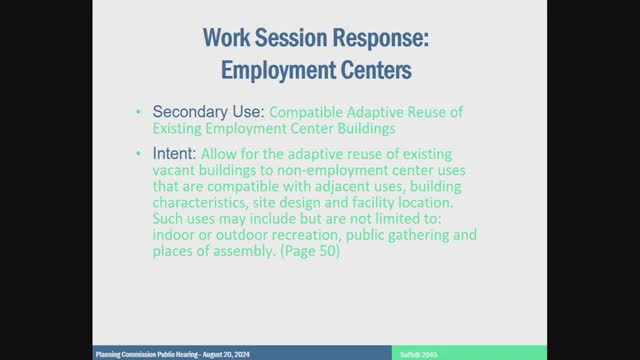Suffolk unveils transformative land use plan for future growth
August 21, 2024 | Suffolk City, Virginia
This article was created by AI summarizing key points discussed. AI makes mistakes, so for full details and context, please refer to the video of the full meeting. Please report any errors so we can fix them. Report an error »

During a recent government meeting, officials discussed significant updates to the land use plan for Suffolk, emphasizing the need for flexibility in adapting large buildings for future uses. The plan now includes language that supports the adaptive reuse of these structures, allowing for a broader range of compatible uses in response to community needs.
The meeting highlighted the importance of community engagement in shaping the updated plan, which has seen increased public participation compared to previous iterations. Officials noted that the plan aims to preserve agricultural land amid growing development pressures, reflecting a commitment to balancing growth with environmental sustainability.
Key changes in the land use plan include a more detailed categorization of land uses, moving away from broad classifications to provide clearer guidance for future developments. This shift is intended to enhance predictability for developers and residents alike, ensuring that the unique character of Suffolk is maintained while accommodating growth.
The meeting also addressed the impact of recent developments at the local port, which has seen increased activity and investment, necessitating adjustments in land use planning to manage the resulting traffic and infrastructure demands. Additionally, the emergence of a new market for utility-scale solar energy was identified as a factor that requires careful consideration in future planning efforts.
Officials underscored the importance of coordinating land use with infrastructure investments, particularly in water, sewer, and transportation systems, to support sustainable growth. The updated plan is set to be finalized by March 2024, with ongoing community input being a central focus of the process. The document detailing the changes is available online, promoting transparency and public awareness of the planning efforts.
The meeting highlighted the importance of community engagement in shaping the updated plan, which has seen increased public participation compared to previous iterations. Officials noted that the plan aims to preserve agricultural land amid growing development pressures, reflecting a commitment to balancing growth with environmental sustainability.
Key changes in the land use plan include a more detailed categorization of land uses, moving away from broad classifications to provide clearer guidance for future developments. This shift is intended to enhance predictability for developers and residents alike, ensuring that the unique character of Suffolk is maintained while accommodating growth.
The meeting also addressed the impact of recent developments at the local port, which has seen increased activity and investment, necessitating adjustments in land use planning to manage the resulting traffic and infrastructure demands. Additionally, the emergence of a new market for utility-scale solar energy was identified as a factor that requires careful consideration in future planning efforts.
Officials underscored the importance of coordinating land use with infrastructure investments, particularly in water, sewer, and transportation systems, to support sustainable growth. The updated plan is set to be finalized by March 2024, with ongoing community input being a central focus of the process. The document detailing the changes is available online, promoting transparency and public awareness of the planning efforts.
View full meeting
This article is based on a recent meeting—watch the full video and explore the complete transcript for deeper insights into the discussion.
View full meeting
